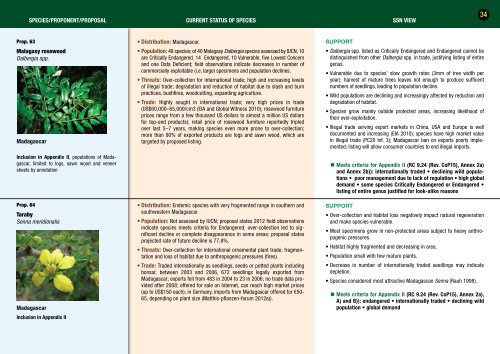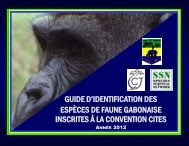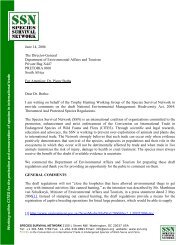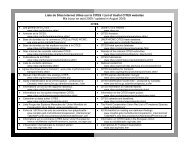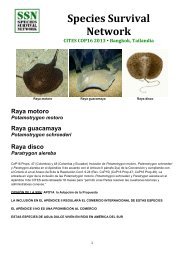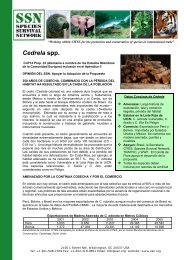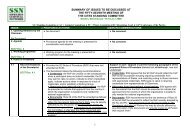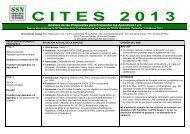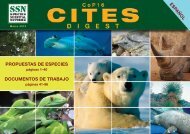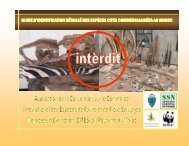CITES CoP16 Digest - Species Survival Network
CITES CoP16 Digest - Species Survival Network
CITES CoP16 Digest - Species Survival Network
You also want an ePaper? Increase the reach of your titles
YUMPU automatically turns print PDFs into web optimized ePapers that Google loves.
SPECIES/PROPONENT/PROPOSAL CURRENT STATUS OF SPECIES SSN VIEW<br />
34<br />
Prop. 63<br />
Malagasy rosewood<br />
Dalbergia spp.<br />
Madagascar<br />
Inclusion in Appendix II, populations of Madagascar,<br />
limited to logs, sawn wood and veneer<br />
sheets by annotation<br />
Prop. 64<br />
Taraby<br />
Senna meridionalis<br />
Madagascar<br />
Inclusion in Appendix II<br />
• Distribution: Madagascar.<br />
• Population: 48 species; of 40 Malagasy Dalbergia species assessed by IUCN, 10<br />
are Critically Endangered, 14 Endangered, 10 Vulnerable, five Lowest Concern<br />
and one Data Deficient; field observations indicate decreases in number of<br />
commercially exploitable (i.e. large) specimens and population declines.<br />
• Threats: Over-collection for international trade; high and increasing levels<br />
of illegal trade; degradation and reduction of habitat due to slash and burn<br />
practices, bushfires, woodcutting, expanding agriculture.<br />
• Trade: Highly sought in international trade; very high prices in trade<br />
(US$60,000–65,000/cm3 (EIA and Global Witness 2010); rosewood furniture<br />
prices range from a few thousand US dollars to almost a million US dollars<br />
for top-end products); retail price of rosewood furniture reportedly tripled<br />
over last 5–7 years, making species even more prone to over-collection;<br />
more than 90% of exported products are logs and sawn wood, which are<br />
targeted by proposed listing.<br />
• Distribution: Endemic species with very fragmented range in southern and<br />
southwestern Madagascar.<br />
• Population: Not assessed by IUCN; proposal states 2012 field observations<br />
indicate species meets criteria for Endangered; over-collection led to significant<br />
decline or complete disappearance in some areas; proposal states<br />
projected rate of future decline is 77.8%.<br />
• Threats: Over-collection for international ornamental plant trade; fragmentation<br />
and loss of habitat due to anthropogenic pressures (fires).<br />
• Trade: Traded internationally as seedlings, seeds or potted plants including<br />
bonsai; between 2003 and 2006, 672 seedlings legally exported from<br />
Madagascar; exports fell from 483 in 2004 to 23 in 2006; no trade data provided<br />
after 2008; offered for sale on Internet, can reach high market prices<br />
(up to US$150 each); in Germany, imports from Madagascar offered for €50-<br />
65, depending on plant size (Matthis-pflanzen-forum 2012a)).<br />
SUPPORT<br />
• Dalbergia spp. listed as Critically Endangered and Endangered cannot be<br />
distinguished from other Dalbergia spp. in trade, justifying listing of entire<br />
genus.<br />
• Vulnerable due to species’ slow growth rates (3mm of tree width per<br />
year); harvest of mature trees leaves not enough to produce sufficent<br />
numbers of seedlings, leading to population decline.<br />
• Wild populations are declining and increasingly affected by reduction and<br />
degradation of habitat.<br />
• <strong>Species</strong> grow mainly outside protected areas, increasing likelihood of<br />
their over-exploitation.<br />
• Illegal trade serving export markets in China, USA and Europe is well<br />
documented and increasing (EIA 2010); species have high market value<br />
in illegal trade (PC20 Inf. 3); Madagascar ban on exports poorly implemented;<br />
listing will allow consumer countries to end illegal imports.<br />
• Meets criteria for Appendix II (RC 9.24 (Rev. CoP15), Annex 2a)<br />
and Annex 2b)): internationally traded • declining wild populations<br />
• poor management due to lack of regulation • high global<br />
demand • some species Critically Endangered or Endangered •<br />
listing of entire genus justified for look-alike reasons<br />
SUPPORT<br />
• Over-collection and habitat loss negatively impact natural regeneration<br />
and make species vulnerable.<br />
• Most specimens grow in non-protected areas subject to heavy anthropogenic<br />
pressures.<br />
• Habitat highly fragmented and decreasing in area.<br />
• Population small with few mature plants.<br />
• Decrease in number of internationally traded seedlings may indicate<br />
depletion.<br />
• <strong>Species</strong> considered most attractive Madagascan Senna (Rauh 1998).<br />
• Meets criteria for Appendix II (RC 9.24 (Rev. CoP15), Annex 2a),<br />
A) and B)): endangered • internationally traded • declining wild<br />
population • global demand


